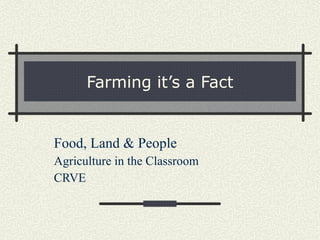
Crve farming fact
- 1. Farming it’s a Fact Food, Land & People Agriculture in the Classroom CRVE
- 2. An Acre is About the Size of a Football Field
- 4. How Are You Connected to agriculture? Personal Care Products Shampoo, soap, cosmetics, lotions, fingernail polish, toothpaste Construction Lumber, paints, brushes, tar paper, drywall, tool handles, particle board Printing Paper, ink, film Health Care Pharmaceuticals, surgical sutures, ointments, latex gloves, x-ray film Sports Uniforms, baseball bats, leather equipment and balls, shoes Manufacturing Adhesives, lubricants, solvents, detergents, polymers Entertainment Film, strings for musical instruments Education Crayons, text books, chalk, desks, pencils, paper Transportation Biofuels including ethanol and biodiesel, lubricants, antifreeze, tires, upholstery, packing materials
- 5. What’s on America’s Dinner Table? Milk 21 gallons Poultry 85.4 pounds Rice 20.5 pounds Cheese 32.7 pounds Eggs 245 eggs Red Meats 116.9 pounds Fresh Fruits 126.2 pounds Flour & Cereal Products 196.9 pounds Fresh Vegetables 202.2 pounds Fats & Oils 86.7 pounds
- 6. Are Farmers Reducing Cropland Erosion? Tons of Soil Lost Per Acre 4.0 3.6 3.1 2.8 2.7 2.6 Today 2002 1997 1992 1987 1982
- 7. Number of people fed annually by one farmer 19 27 46 73 115 129 139 143
- 8. What is a billion? If you had 1 million dollars and had to spend $1,000 dollars every day, your money would run out in 1000 days. If you had 1 billion dollars and had to spend $1,000 every day, your money would run out for 2,740 years.
- 9. Who Pays the Least for Food? Of the 10 percent of disposable income Americans spend on food each year, 58 percent is for food eaten at home and 42 percent is for food eaten away from home.
- 10. State that produces the most food and has the highest farm-gate sales USDA – ERS: 2009 Rank State $ in Thousands 1 California $36,574,850 2 Texas $19,074,827 3 Iowa $19,036,853 4 Nebraska $14,555,820 5 Minnesota $12,538,429 6 Kansas $11,729,328 7 Illinois $11,678,609 8 Wisconsin $8,858,242 9 North Carolina $8,691,099 10 Indiana $7,775,742
- 11. What is the U.S. Share of World Production? Soybeans 33% Corn 41.9% Eggs 8.5% Beef and Veal 20.6% Cotton 15.9% Milk 17% Wheat 9.2%
- 12. How Many Farms and Farmers?
- 14. Family Farms & Family Farm Production
- 15. What is USDA’s Budget? In 2008: $94.8 billion Food Assistance and Nutrition Programs $55.5 Food Safety and Marketing & Inspection $2.3 Conservation Programs $5.0 Research, Education & Economics $2.7 Forest Service $6.2 Foreign Ag Service $2.2 Rural Development $3.0 Farm Programs $13.0 Risk Management $4.5 (in billions)
- 16. Where Does Your Food Dollar Go? 3.5¢ Depreciation 4¢ Rent 2.5¢ Interest 1.5¢ Repairs 3.5¢ Business Taxes 3.5¢ Other Costs 4¢ Advertising 4.5¢ Profits 3.5¢ Energy 4¢ Transportation 8¢ Packaging 38.5¢ Off Farm Labor 19¢ FARM 81¢ OFF-FARM
- 18. Who Imports U.S. Farm Products?
- 19. What Do We Trade on the World Market? U.S. Ag Exports = $115 billion Top Exports (billions)
- 20. What Do We Trade on the World Market? Top Imports (billions) U.S. Ag Imports = $79 billion
- 22. Farms: Things we grow and raise. Like dairy cows. What a Dairy Cow consume and produces in a day? 3.3 pounds of butter OR 8.1 gallons of milk OR 7.0 pounds of cheese 35 gallons of water 20 pounds of grain and concentrated feed 35 pounds of hay or silage VALUE of a cow’s daily production = $ 11.55 COST Feed = $4.50 Supplies = $3.00 Bldgs./overhead = $3.75 ______________________ Daily Costs = $11.25 RETURN on Labor = $0.30
- 24. Food: What’s in the Grocery Store and Restaurants: Pizza for example Your favorite pizza originates on America’s farms and ranches Top-Producing States: Mozzarella Cheese (Dairy Products) California, Wisconsin, Pennsylvania Tomato Sauce (Fresh Tomatoes) California, Florida, Virginia Pizza Dough (Winter Wheat) Kansas, Oklahoma, South Dakota Sausage (From Hogs) Iowa, North Carolina, Minnesota Spinach California, Arizona Mushrooms Pennsylvania, California Onions Georgia, California, Texas Green Peppers California, Florida Pineapple Hawaii
